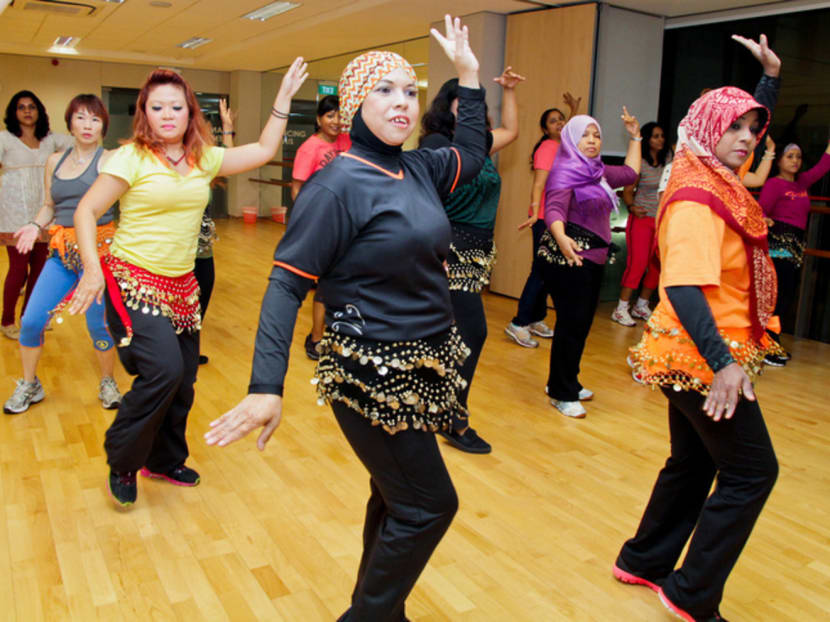More S’pore seniors opting for trendy, high-energy workouts
Singapore — Despite having zero dance experience, Madam Elsie Lim, 63, signed up for a high-energy K-Pop dance fitness class at her community centre last year, where she shimmied her way across the dance studio alongside other participants about her age.

Seniors at a BollyX Get Fit Dance workout, inspired by Bollywood routines. Photo: People’s Association
Singapore — Despite having zero dance experience, Madam Elsie Lim, 63, signed up for a high-energy K-Pop dance fitness class at her community centre last year, where she shimmied her way across the dance studio alongside other participants about her age.
“I wasn’t the oldest participant there. Some of them were in their 70s,” said Mdm Lim, a homemaker.
Similarly for Mdm Prasana Bhaskaran, 56, age was no barrier to learning a new sport.
Last year, the grandmother-of-one donned a swimsuit and picked up swimming through the North West SwimSafer Club for Seniors, a healthy-living initiative by North West Community Development Council in support of the national SwimSafer programme. Today, she swims laps despite having a chronic heart problem.
Mdm Lim and Mdm Prasana represent a growing trend of baby boomers jumping on the fitness bandwagon.
In the past five years, some fitness- and sports-club operators have observed an increasing number of participants aged 50 and older looking to improve their fitness levels.
North West SwimSafer Club for Seniors has expanded from one to eight clubs since its launch in 2014. To date, about 500 seniors have enrolled in the programme, the majority without any prior water skills.
The number of seniors participating in fitness classes at community centres island-wide has increased from 150 in 2011 to about 15,000 as of November last year, said a People’s Association spokesperson.
At present, older adults make up about a quarter of the total class participation.
Trendy high-energy workouts are often on the agenda of these active agers — gentle exercises do not cut it anymore.
“When I started conducting classes in 2010, most of the participants were mainly in their 30s and 40s. Today, we see people coming in with their mothers and older relatives pushing 70. What is interesting is that some of the older participants have even better stamina than the younger ones, who sometimes lose steam halfway through the class,” said People’s Association fitness trainer Ramlah Sameejan, 54, who leads the BollyX Get Fit Dance class at several community centres. BollyX is a dance fitness routine inspired by Bollywood dance sequences.
A Health Promotion Board (HPB) spokesperson said the number of seniors taking part in its Sundays @ The Park programme, which comprises instructor-led workouts across 50 parks in Singapore, has gone up 10 per cent in the past year.
Mr Eugene Lee, director of marketing and communications at Singapore Sports Hub, estimated that the percentage of older participants attending its in-house community programme Experience Sports, which runs activities such as pilates and high-impact cardio workouts, has jumped from less than 5 per cent to about 33 per cent since it started in June 2014.
Ms Sarah See, head of marketing at Fitness First Singapore, attributed the trend to increased awareness of the benefits of a healthy and active lifestyle.
For some people, such as Mdm Prasana, who has a chronic heart problem, sport is a fun way to keep chronic illnesses in check. Exercising in a group also allows her to socialise with her peers.
“My doctor suggested that I take up swimming as a means of managing my heart problem,” she said. “I’m happy to say I no longer have to take as much medication, now that I am fitter and stronger.
“Exercise has transformed my health and outlook in life,” added Mdm Prasana, who now swims three times a week.
Physical activity has been shown to reduce the risk of premature death and diseases such as coronary heart disease, hypertension and diabetes.
Studies suggest it may be the secret to longevity.
A review of past research, published online in the British Journal of Sports Medicine last August, found that even daily 15-minute brisk walking, cycling or swimming could help older adults live longer.
In general, 150 minutes of physical activity every week is recommended by professionals.
MORE INJURIES
But as the number of seniors eager to try out new exercise routines grows, so have sports and exercise-related injuries. The number of older adults with such injuries referred to the Tan Tock Seng Hospital’s (TTSH) physiotherapy department has doubled in the past five years, said senior physiotherapist Justin Wee.
“Previously, it would be fairly uncommon for us to see seniors with sports- and exercise-related injuries. We used to see (fewer) than 10 of such cases every three months,” he said.
Patients in this age group tend to suffer from joint-related knee issues, muscle strains and overuse injuries, which are more common due to lower flexibility and strength, poorer movement and motor control, as well early degenerative changes in the joints, he said.
Seniors should be aware of their physical ability and seek medical advice before embarking on any sport, added Mr Wee.
Fitness First Singapore’s Ms See suggested that older adults adopt a tailored approach, such as engaging a personal trainer, to get fitter.
In general, older adults with severe osteoporosis or osteoarthritis, blood-clotting disorders or who have undergone joint replacement should steer clear of high-impact sports and opt for gentler exercises such as pilates and aqua aerobics, said Mr Wee.






